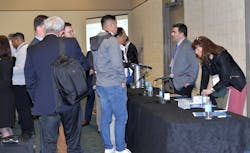Climate Change, Extreme Weather Events Shaping Global HVACR Market
Caption: AHR attendees talk with speakers from nonprofit BSRIA global trends in heating, renewables, cooling, refrigeration, IoT and wellness buildings.
Condensing boilers, combi boilers and heat pumps are all heating technologies that will continue to see steady growth as the global HVACR community works on what will replace gas boilers in the face of climate change and its effect on weather, noted Socrates Christidis of BSRIA, a UK-based nonprofit that aims to make buildings better. He and three of his colleagues spoke to AHR Expo attendees Feb. 3 in Orlando, Fla., about global HVACR trends.
Christidis noted that most of the growth in boilers will come from replacement, not new construction. The United States has a large number of noncondensing boilers that are need of, or will be in need of, replacement. The U.S. heat pump market was 4 million units in 2019; most are sold in new construction.
“The main challenge is the energy costs of electricity vs. gas,” he noted. “U.S. electricity prices will increase in the next five years. Heat pump sales will grow strongly.”
Sales of wireless access points for connected devices in commercial buildings will increase 19 percent; sales building security products will rise to 23 million units by 2025, said BSRIA’s Lone Hanson.
“As technology keeps improving, equipment and software may be replaced, but not the network,” she said. Bluetooth technology centers in buildings and monitor HVAC systems as well as building automation systems.
Smart home technology is driving innovation in the commercial area, Hansen said.
Turning to the air conditioning, growth is shown in chillers, ductless split systems and low global warming potential refrigeration and VRF technology, explained BSRIA’s Saziye Dickson. Mini VRF tech used in residential and light commercial applications will see double-digit growth in the United Sates, she said. “The United States is moving toward ductless options,” she added.
Lastly, BSRIA’s Anette Holly noted that wellness real estate – “healthy buildings” – is growing 6 percent annually, with a large market in the United States. Globally, it could reach $180 billion by 2022.
About the Author

Kelly L. Faloon
Freelance Writer/Editor
Kelly L. Faloon is a contributing editor and writer to Contracting Business magazine, Contractor and HPAC Engineering. The former editor of Plumbing & Mechanical magazine, Faloon has more than 20 years experience in the plumbing and heating industry. She started a freelance writing and editing business in 2017, where she has a varied clientele.
Faloon spent 3 1/2 years at Supply House Times before joining the Plumbing & Mechanical staff in 2001. Previously, she spent nearly 10 years at CCH/Wolters Kluwer, a publishing firm specializing in business and tax law, where she wore many hats — proofreader, writer/editor for a daily tax publication, and Internal Revenue Code editor.
A native of Michigan’s northern Lower Peninsula, Faloon is a journalism graduate of Michigan State University. You can reach her at [email protected].
